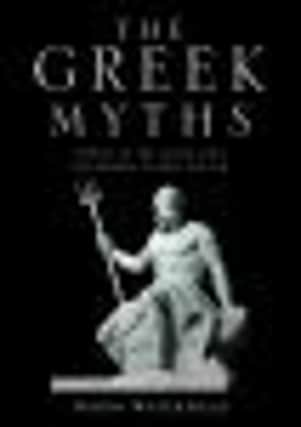Book review: The Greek Myths by Robin Waterfield


The answers, and much more, lie within the pages of a magnificent new book which explains and retells some of the most thrilling, romantic and unforgettable stories in human history.
From Achilles rampant on the fields of Troy to the gods at sport on Mount Olympus and from Icarus flying too close to the sun to Theseus and the wily Odysseus, these timeless Greek myths exert a fascination that has endured for 3,000 years and influenced cultures far and wide.
Advertisement
Hide AdAdvertisement
Hide AdBeginning at the dawn of human civilization, when the Titan Prometheus stole fire from Zeus and offered mankind hope, The Greek Myths transports readers to the majestic, magical and mythical world of gods and heroes.
Renowned classicist Robin Waterfield and his wife, writer Kathryn Waterfield, use some of the world’s greatest paintings, sculpture and literature to create a sweeping panorama of the romance, intrigues, heroism, humour, sensuality and brutality of ancient myths and legends.
Art, books, poetry, plays and films have all been influenced and inspired by these epic tales of war and adventure, love, jealousy, murder, rape and revenge. It’s as if the legends have the ability to tap into some deep layer of the human mind.
The ancient Greeks illustrated their walls, tableware, armour and even their furniture with artwork that told stories and within these tales were lessons for their children about how to behave, religious rituals, the origins of the universe and the power of emotions.
Advertisement
Hide AdAdvertisement
Hide AdMany were breathtakingly brutal ... Cronus, leader of the first generation of Titans, devoured his own children to prevent them usurping him, Thyestes, son of the King of Olympia, was served up his dead sons to eat and Acrisius, King of Argos, locked up his daughter and grandson in a wooden chest and threw them into the sea.
Sacrifice and superstition were at the heart of everyday life for the ancient Greeks; animals would be slaughtered on a domestic altar to please the gods and grain tossed onto the household hearth with a prayer for the coming day.
Oracles, the mouthpiece of the gods, were consulted by both individuals and states. At Delphi, the diviner was a woman who sat in the temple of Apollo, entered a trance and relayed messages from the god.
The Greek mythological heroes emphasised to the populace the need ‘to strive always to be the best,’ as Homer put it. This meant not just defeating opponents but giving advice in council and shining in every field of endeavour.
Advertisement
Hide AdAdvertisement
Hide AdAncient Greek dramatists drew on the myths and legends for the plots of their plays which were performed in theatres that could accommodate thousands of spectators and featured actors who wore masks and trained as athletes.
There they would act out stories like the terrible curse that plagued the royal houses of Mycenae and Thebes, Jason and the Golden Fleece, Perseus and the terrifying Gorgon, the wooden horse and the sacking of Troy.
The Greek Myths is not just a treasure trove of amazing tales but a catalogue of Greek myth in art through the ages. Packed with 120 vivid illustrations of remarkable variety and beauty, and brimming with fascinating facts, this is a book to read and treasure.
(Quercus, hardback, £20)